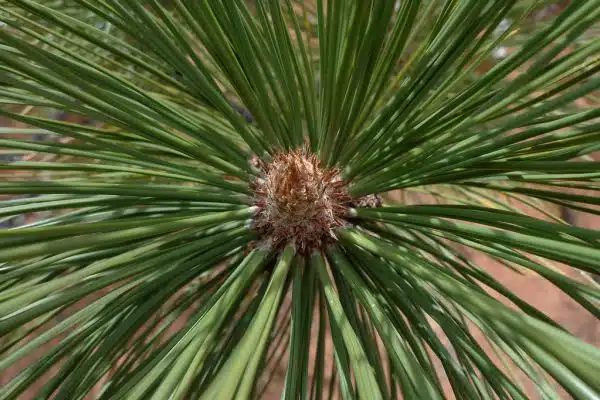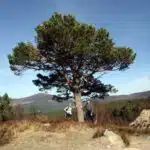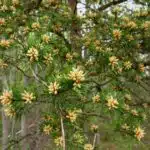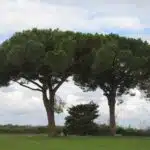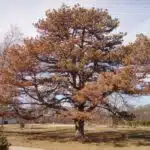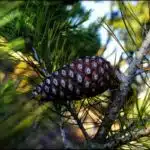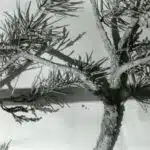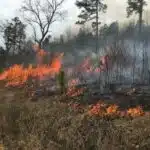Ponderosa pine, also known as Western yellow pine, is a tall, majestic tree that can grow up to 200 feet in height. This species of pine is native to western North America and can be found in the Rocky Mountains, Sierra Nevada, and Cascade Range. It is a popular choice for landscaping due to its attractive bark, long needles, and fragrant resin.
Growing and caring for Ponderosa pine requires careful attention to its specific needs. This tree thrives in areas with plenty of sunlight and well-draining soil. Proper pruning techniques are also important for maintaining healthy growth and preventing damage from high winds or heavy snowfall. In this article, we will explore the various aspects of growing and caring for Ponderosa pine, providing you with the knowledge you need to keep these magnificent trees thriving on your property.
Understanding Ponderosa Pine: An Overview
Ponderosa pine, scientifically known as Pinus ponderosa, is a large coniferous tree species that belongs to the Pinaceae family. It is native to the western United States and Canada, where it grows in various environments such as dry and moist forests, mountainsides, and grasslands. The tree can reach heights of up to 250 feet with a trunk diameter of up to 8 feet. Ponderosa pine is an important species ecologically because it provides habitat for numerous wildlife species, including birds and mammals.
Apart from ecological importance, ponderosa pine has significant commercial uses. Its wood is durable and strong, making it ideal for construction purposes such as building poles, railroad ties, furniture, and flooring. Additionally, the tree’s bark contains a resin that can be extracted for use in products like varnish and turpentine. Moreover, ponderosa pine nuts are edible and nutritious.
When considering growing a ponderosa pine tree on your property or elsewhere, it is crucial to choose the right location for optimal growth. This entails selecting a spot that receives ample sunlight throughout the day and has well-draining soil. Furthermore, avoid areas prone to strong winds or droughts as they can damage or stunt the growth of young trees. By choosing the right location for your tree upfront, you set yourself up for success in its care and growth over time.
Choosing The Right Location For Your Tree
When planting a ponderosa pine tree, choosing the right location is crucial for its growth and survival. The best season to plant a ponderosa pine is during the early spring or fall when temperatures are mild and there is adequate moisture in the soil. This allows the tree to establish its roots before facing extreme heat or cold.
When selecting a location for your ponderosa pine tree, it is important to consider ideal conditions for growth. Ponderosa pines thrive in areas with full sun exposure and well-draining soil that is slightly acidic. They prefer areas with good air circulation, so avoid planting them in low-lying areas or near buildings that can block airflow.
Additionally, ensure that the selected location has enough space for the mature size of your ponderosa pine tree. These trees can grow up to 60 feet tall and have a spread of 30 feet, so it’s essential to plant them at least 20 feet away from any structures, power lines or other trees.
To summarize, choosing the right location for your ponderosa pine tree is crucially important to its health and longevity. Planting during the best season and providing ideal conditions such as full sun exposure, well-draining soil, good air circulation and ample space will help ensure a successful planting process. In the subsequent section, we will discuss soil requirements for growing healthy ponderosa pines.
Soil Requirements For Ponderosa Pine
The soil composition is an important factor when it comes to the growth of ponderosa pine. These trees prefer well-draining soils, which means that they do not tolerate waterlogged soils. Therefore, it’s necessary to ensure that the soil has excellent drainage capabilities. Sandy loam and loamy sands are ideal soil types for ponderosa pine as they provide good aeration and drainage.
Apart from good drainage, the pH levels of the soil should be checked periodically. Ponderosa pine thrives best in slightly acidic soils with pH levels ranging between 5.5 to 6.5. If the soil pH is outside this range, it can impact nutrient uptake and ultimately affect tree growth. Soil tests can help determine whether your soil has the right pH balance or not.
In summary, growing healthy ponderosa pines requires careful consideration of the soil composition and pH levels. The ideal soil type for these trees is sandy loam or loamy sands with good drainage capabilities. Additionally, maintaining a slightly acidic pH level between 5.5 to 6.5 is critical for optimal tree growth and nutrient uptake. With proper attention to these factors, you can expect healthy and robust ponderosa pines on your property! In order to maintain their health, watering and fertilization tips must also be considered- let’s explore this further in the next section!
Watering And Fertilization Tips
Water is the lifeblood of any plant. It helps transport nutrients from the soil to the different parts of the tree, aiding in photosynthesis and cellular respiration. However, ponderosa pine is a drought-tolerant species that can survive with minimal watering. In fact, overwatering can lead to root rot, which can be fatal for the tree. Therefore, it’s crucial to strike a balance between providing enough water and not drowning your ponderosa pine.
Fertilization is also essential for maintaining healthy ponderosa pine trees. Nutrient deficiencies can cause stunted growth, yellowing or browning of needles, and other problems that can make your tree more susceptible to pests and diseases. However, too much fertilizer can also harm your tree by burning its roots or causing excess growth that weakens its structure. Therefore, it’s important to consult with an arborist or tree care specialist to determine the optimal fertilization schedule and amount based on your specific soil conditions and climate.
In summary, watering and fertilization are critical components of caring for ponderosa pine trees. While they are drought-tolerant species that require minimal watering, they still need sufficient moisture and nutrients to grow healthy and strong. By striking a balance between these two factors and consulting with experts when necessary, you can ensure your ponderosa pine thrives for years to come without succumbing to nutrient deficiencies or other problems that may arise due to improper care practices.
To maintain healthy growth in a ponderosa pine tree requires more than just regular watering and fertilizing; it also entails pruning techniques that help shape its canopy structure while promoting healthy branching patterns. Pruning involves removing damaged or diseased branches while thinning out dense foliage areas creating more sunlight penetration into the canopy interior leading to better needle distribution throughout the entire tree crown area, increasing air circulation minimizing disease development potential. With proper pruning techniques applied at an early age during its formative years will help ensure the tree’s optimal health, vitality and longevity.
Pruning Techniques For Healthy Growth
After properly watering and fertilizing your ponderosa pine, it’s important to consider the pruning techniques that will promote healthy growth. Pruning frequency is dependent on the age of the tree and its specific needs. For young trees, it’s recommended to prune annually in order to shape the tree and remove any damaged or diseased branches. As the tree matures, pruning can be done less frequently, with a focus on removing crossing branches and maintaining overall structure.
When it comes to pruning tools, always use sharp and clean equipment to avoid damaging the tree or spreading disease. Hand pruners are suitable for smaller branches while loppers or a handsaw are necessary for larger limbs. When removing branches, cut just outside of the branch collar (the raised area where the branch meets the trunk) to promote healing and prevent decay.
Proper pruning techniques not only improve the overall appearance of your ponderosa pine but also help prevent pest infestations and disease. In fact, many common diseases such as pine wilt can be prevented through regular pruning practices. In addition to regular maintenance pruning, keep an eye out for signs of pests or diseases such as scale insects or needle rust. Early detection is key in addressing these issues before they cause irreversible damage to your tree.
Dealing With Pests And Diseases
Ponderosa pines, with their majestic stature and vibrant green needles, are a sight to behold. However, even the most hardy trees can fall prey to pests and diseases if not properly cared for. Fortunately, there are steps you can take to prevent infestations and treat fungal infections that may arise.
One of the most effective ways to prevent pest infestations is through proper tree maintenance. Regular pruning helps remove dead or dying branches and improves airflow around the tree, making it less hospitable to pests. Additionally, keeping the area around your tree free from debris and deadwood helps eliminate hiding places for insects.
Fungal infections can be more challenging to deal with than pests because they often require chemical treatments. However, there are some natural remedies that you can try before turning to chemicals. For instance, removing infected branches and leaves as soon as possible can help stop the spread of infection. Additionally, ensuring that your tree receives adequate water and nutrients strengthens its immune system, making it more resistant to disease.
To protect your ponderosa pine from wildlife damage such as deer browsing or bark stripping by rodents like squirrels or rabbits you can use physical barriers such as metal mesh wrapped around the trunk of your tree or deer netting placed over individual trees or entire planting areas. Another option is using repellents such as sprays made from rotten eggs or predator urine which can deter animals from approaching your trees. Implementing a mixture of these methods will help reduce damage caused by wildlife and keep your ponderosa pine healthy for years to come.
Protecting Your Tree From Wildlife Damage
- To deter animals from damaging a ponderosa pine, the first line of defense is to install a physical barrier such as an animal-proof fence around the tree.
- Additionally, the area surrounding the tree can be kept clear of low-hanging branches and other debris that animals could use as cover to access the tree.
- To prevent damage, any broken branches and wounds should be pruned as soon as possible to prevent further damage from wildlife.
- Proper fertilization and watering of the tree is also key in promoting a healthy tree, as a healthy tree is better able to withstand wildlife damage.
Deterring Animals
It can be disheartening to see your beloved ponderosa pine tree being damaged by wildlife. These creatures don’t mean to harm our trees, but their natural instinct drives them to search for food and shelter wherever they can find it. As an arborist or a tree care specialist, it’s essential to protect the tree from wildlife damage.
One way to deter animals is by using natural deterrents. For instance, you can plant companion plants that release oils that are unpleasant for animals like deer or rabbits. Some examples of such plants include lavender, sagebrush, and catmint. Additionally, you could try placing a motion-activated sprinkler near the base of your ponderosa pine tree. The sudden burst of water will scare off any animal that comes too close.
Another option is to install fencing around the tree. Fencing options range from metal mesh wire enclosures to wooden picket fences that add aesthetic value while keeping out unwanted visitors. Make sure the fence is tall enough and extends deep enough into the ground so that animals cannot dig under it or jump over it. Remember that fencing alone may not be enough; you may need to supplement this with other methods like repellents or scare tactics.
Protecting your ponderosa pine tree from wildlife damage requires planning and patience. Using natural deterrents and installing fencing are just some of the ways you can keep your tree safe and healthy in its environment without harming any animal in the process. With these measures in place, you’ll be able to enjoy watching your tree grow tall and strong for years to come!
Preventing Damage
As an arborist or tree care specialist, preventing damage to your beloved ponderosa pine tree is a top priority. While wildlife can cause significant damage to your tree, it’s not the only threat you should be worried about. Storms and bark beetles are also common causes of damage that require preventative measures.
To protect your tree from storm damage, proper pruning techniques should be employed to remove any dead or weak branches that could fall during high winds. Additionally, installing cables or braces may help support the tree’s branches and trunk in times of heavy wind or snow loads. When planting new trees, consider their location and ensure they are planted away from power lines or other structures that could pose a risk during storms.
Bark beetles are another common threat to ponderosa pines. These insects burrow into the bark of the tree, causing extensive damage that can lead to the death of the entire tree. To prevent bark beetle infestations, it’s important to keep your trees healthy through regular watering and fertilization. Additionally, removing any infected or dead trees near your property can help prevent further infestations from spreading. Taking these preventative measures can help ensure the longevity and health of your beloved ponderosa pine for years to come.
Winter Care And Maintenance
Protecting your ponderosa pine from wildlife damage is crucial to its survival, but it is equally important to prepare it for the cold winter months. Winter protection for your pine will ensure its growth and health in the coming spring season. One of the primary concerns during winter is frost prevention, which can cause severe damage to the tree’s needles and bark.
To protect your ponderosa pine during winter, you should consider wrapping its trunk with burlap or other protective material. This will also help prevent sunscald or injury caused by sudden changes in temperature. Additionally, watering your tree deeply before the first freeze will help keep it hydrated through the winter months.
Here are some more tips for winter care and maintenance of your ponderosa pine:
- Prune away any damaged or diseased branches before winter sets in.
- Avoid using fertilizer during fall as it can encourage new growth that may not have enough time to harden off before freezing temperatures arrive.
- Apply a layer of mulch around the base of your tree to help insulate its roots and retain moisture.
- Protect young trees from snow buildup by gently brushing off accumulating snow from their branches.
- If you live in an area prone to heavy snowfall or ice storms, consider wrapping young trees with twine or rope to prevent breakage.
Winter protection and care are essential for maintaining a healthy and thriving ponderosa pine. By following these tips, you can ensure that your tree remains robust throughout the colder months. In the next section, we will discuss propagating ponderosa pines: from seed to tree.
Propagating Ponderosa Pine: From Seed To Tree
The process of propagating ponderosa pine can be a rewarding experience for those who appreciate the beauty and benefits of this majestic tree. Germinating seeds is the first step in the propagation process, which involves collecting cones from mature trees and extracting the seeds. Once extracted, the seeds can be stratified in a moist medium for several months before planting. This helps to break their dormancy and ensure successful germination.
Transplanting techniques are also an essential aspect of propagating ponderosa pine. When the seedlings reach 6-8 inches in height, they can be transplanted into larger containers or directly into the ground. It’s important to choose an appropriate location with well-drained soil, full sun exposure, and protection from strong winds. The seedlings should be watered regularly but not overwatered, as this can lead to root rot.
Incorporating these techniques into your gardening routine can result in a beautiful stand of ponderosa pines in your landscape. In addition to their aesthetic value, they provide numerous benefits such as erosion control, wildlife habitat, and carbon sequestration. By taking the time to propagate and care for these trees properly, you’ll not only serve yourself but also contribute positively to our environment.
| Advantages | Disadvantages |
|---|---|
| Provides shade | Susceptible to bark beetle infestations |
| Reduces erosion | Requires ample space |
| Attracts wildlife | May drop needles and cones |
| Improves air quality | Slow-growing |
As you can see from the table above, there are both advantages and disadvantages associated with growing ponderosa pine. However, with proper care and attention, these trees can thrive in a variety of settings and provide many benefits for years to come. In the next section, we will discuss how to enjoy the beauty and benefits of ponderosa pine in your day-to-day life.
Conclusion: Enjoying The Beauty And Benefits Of Ponderosa Pine
After successfully propagating Ponderosa Pine from seed to tree, it is time to focus on how to grow and care for these majestic trees. Ponderosa Pine is a hardy species that can adapt to various soil types, but it prefers well-draining soil. It also thrives in areas with full sun exposure and minimal shade. Proper irrigation is crucial during the first few years of growth, but once established, Ponderosa Pine can tolerate moderate drought conditions.
Regular pruning is necessary to maintain the tree’s shape and promote healthy growth. Dead or damaged branches should be removed promptly to prevent disease infestation. Fertilization is not often required for Ponderosa Pine trees as they can obtain nutrients from the surrounding soil. However, if necessary, slow-release fertilizers can be applied during the growing season.
The Benefits of Ponderosa Pine are numerous, from providing shade and shelter for wildlife to improving air quality and reducing noise pollution. These trees also add aesthetic value to any landscape design. Here are four Landscape Design Ideas that incorporate Ponderosa Pine:
- Create a naturalistic setting by planting several Ponderosa Pine trees together.
- Use smaller-sized Ponderosa Pine trees as accent plants in rock gardens or xeriscapes.
- Highlight the beauty of mature Ponderosa Pine trees by placing them as focal points in large open spaces.
- Add variety and contrast to a woodland garden by planting Ponderosa Pine among other native tree species.
In summary, growing and caring for Ponderosa Pine requires proper irrigation, pruning, and occasional fertilization. These majestic trees offer numerous benefits such as improving air quality and adding aesthetic value to any landscape design project. By incorporating some of the Landscape Design Ideas mentioned above into your next project, you can create a beautiful natural environment that serves both humans and wildlife alike without compromising on style or functionality.
Conclusion
Ponderosa Pine is a majestic tree that can add a touch of natural beauty to any landscape. With proper care and maintenance, these trees can grow to be tall and strong, providing shade, shelter, and aesthetic appeal for years to come.
To ensure the health and longevity of your Ponderosa Pine, it is important to understand its unique requirements. From selecting the right location and soil type to watering and fertilization techniques, each step plays a crucial role in promoting healthy growth.
Pruning is also an essential aspect of caring for Ponderosa Pine. By removing dead or diseased branches, you can prevent further damage to the tree while encouraging new growth. Additionally, protecting your tree from wildlife damage during the winter months is vital for preserving its structural integrity.
Overall, growing and caring for Ponderosa Pine requires patience, dedication, and attention to detail. However, by following these guidelines and techniques provided by a knowledgeable arborist or tree care specialist, you can enjoy the many benefits of this beautiful species for years to come.
Image Credits
- “Ponderosa Pine” by slashvee (featured)

